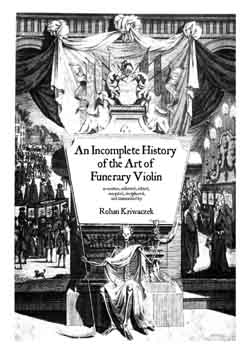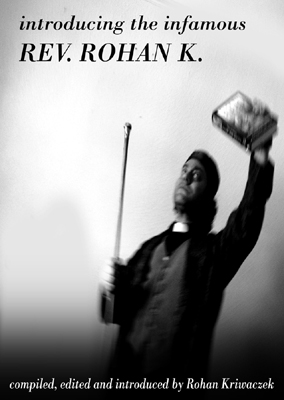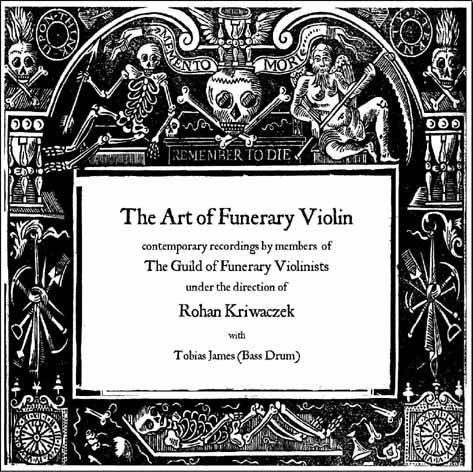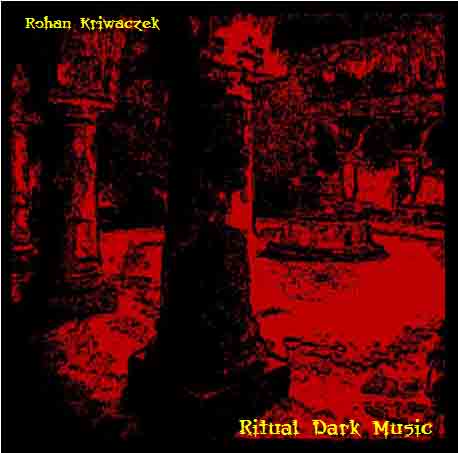
an extract from TEXT NUMBER SIX
One of the stranger fashions to have been taken up by the wealthy and celebrated in recent years is that of staging one’s own funeral. And indeed it is a great illustration of how we, the readers of tabloid newspapers and glossy magazines, can become acclimatised to that which is absurd, bizarre and utterly extraordinary. The other day, whilst standing in a supermarket queue, I overheard a conversation between two middle aged and somewhat overweight women flicking through Zoo magazine. Suddenly the elder of the two said “Ooh, they’ve got Ozzie’s funeral”. The other leant over to take a look. “How many goats did he have?” After a brief pause the first replied “sixteen, and four ostriches.... Eddie Izzard was the priest.” They turned the page. “Oh, doesn’t Kelly look gorgeous in black.” “I bet those shoes cost a fortune.” Then one pointed at some picture I couldn’t see and they both erupted in laughter. “Did she really think she could get away with that!”... “J-Lo’s was better, more colourful.” I was fascinated by the casualness with which they discussed what I felt to be a considerably surreal event. To them it was little more than a fashion parade, an excuse to admire and condemn the tastes and figures of younger, richer, prettier people than themselves; to me it was an expression of unprecedented decadence amongst the celebrity classes, and, as with all expressions of decadence, a most revealing window to the many hidden (and not so hidden) sicknesses within.
This unlikely fashion for the premature staging of one’s own death ritual should not be confused with the ancient rituals of rebirth that are known to date back to the days of the Pharaohs, if not earlier. Those were part of a larger whole, a manifestation of religious beliefs that placed the political leader in the role of a God, whose rebirth on a monthly, or in some cases daily, cycle was deemed to be essential for the health of society. Their political purpose was the demonstration of hierarchy, and the reinforcement of power bases. They remained fixed and unchanged across generations. By contrast, this modern manifestation is an expression of individual concerns and values and though it naturally relates to issues within the larger society it is essentially a personalised ritual, in most cases designed as a public display of the aesthetic or philosophy of what I shall refer to as the “notionally deceased”.
To fully grasp the essence of the mock-funeral it is important to contemplate for a moment the essence of a real funeral, that being, at least in today’s society, the cathartic expression of grief. A funeral without grief is essentially an empty vessel, devoid of meaning or motivation, and it is that vacuum which lies at the heart of the mock-funeral. How it is filled, be it with statements of aesthetic, commercial implications, protest, egotism or simply fashion, can be a very telling indicator of the spiritual and indeed mental health and concerns not just of the persons involved, but also of the times in which they live.
Let us consider for how this all started. The earliest known example of a mock-funeral being staged purely for aesthetic or artistic reasons is that of Francis Featherstone in 1894. Featherstone, a self proclaimed pre-modernist poet of the late nineteenth century and spiritual leader of the movement known as the Devonshire Cathartists, became, towards the end of his life, increasingly fixated upon the crucifixion and subsequent resurrection of Jesus, despite being an ardent atheist and proudly devout sinner. On July 4th 1894, before a crowd of around thirty fellow poets and other pre-modernist artists, he was ritually enshrouded and be-coffined, placed upon a pauper’s hearse and pulled, by his followers, eight miles into the depths of Dartmoor, to a ready dug grave. The coffin was interred at midday, fires were lit, toasts were given and Featherstone’s epic poem, Reinventing Lazarus (now sadly lost) was recited by Sir Henry Irving, with occasional breaks for light refreshments. Finally, upon completion of the recitation some twelve or so hours later, the grave was unfilled and Featherstone arose from the ground at midnight, cleansed and renewed, miraculously reborn through Art. At least that is how the event is presented in his journal. A local newspaper report paints a slightly different picture:
This last Sunday was witnessed a further demonstration of the increasing lunatic eccentricity of local “character” Francis Featherston[sic.] and his dubious associates. In what can only be described as a most perplexing comedy of sanctimony Featherstone had himself be-coffined amid considerable invented ceremony, and then dragged upon an offall[sic.] cart into the depths of the moor. Our source, who followed the proceedings at what was described as a respectable distance, reports that upon arrival atop Crow Tor the coffin was placed in a ready dug grave and covered over, following which the most debaucherous of celebrations ensued involving much drunkenness and not inconsiderable nudity. Among the revellers were the actor Henry Irving and Exeter stationary magnate Sir Edmond Whitstable ... What possible motive he might have had for such an act of assured self-importance is hard to fathom, but one would have thought Mr. Featherston[sic.] would be keeping a low profile given the recent allegations levelled against him...
Whichever account is closer to the actual occasion, it is clear that the proceedings were conducted with considerable ritual intention, and it should be noted that even drunken nudity would not be undertaken lightly in February on Dartmoor where temperatures frequently fall well below freezing. ...
- Read the Improtant Preface to the Second Edition
- Read an extract from On the Dancing Death of Amanda Palmer
- Read an extract from On the Unsung Death of Amanda Palmer
- Read an extract from Appendix V
|







